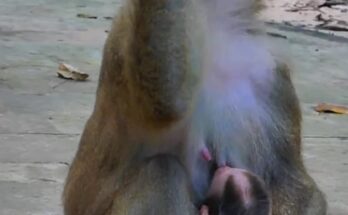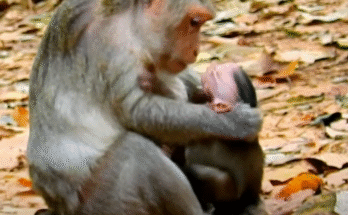In the wild, the bond between a mother monkey and her newborn is one of the strongest relationships in the animal kingdom. From the moment of birth, the infant clings to its mother’s body, relying on her for warmth, protection, and nourishment. However, as the baby grows, the mother gradually encourages independence, a process that is crucial for survival in the wild. This transition, known as weaning, is a delicate but necessary step in the young monkey’s development.
The Early Bond
At birth, a newborn monkey is completely dependent on its mother. It spends most of its time nestled against her chest, nursing frequently and learning about the world from the safety of her embrace. The mother is highly attentive during this stage, grooming her infant, carrying it everywhere, and responding quickly to its cries. This early bond provides not only physical security but also emotional stability, shaping the infant’s confidence and social behavior.
During these first few weeks, the baby monkey is rarely separated from its mother. It learns by observing her and interacting with siblings or other members of the troop. The mother teaches essential survival skills, such as recognizing edible plants, interpreting social cues, and identifying potential threats. At this stage, however, the infant is still too young to explore on its own and relies entirely on its mother for food and protection.
The Beginning of Weaning
As the baby monkey grows, the mother starts to introduce small changes that encourage independence. She may nurse the infant less frequently or shift its position when it tries to suckle. At first, the baby protests, crying or clinging more tightly, but the mother remains firm, teaching it that food will not always be instantly available.
Weaning is not just about reducing milk intake; it also involves introducing solid foods. The mother gradually encourages her infant to try fruits, leaves, and insects by modeling the behavior herself. She may offer bits of food or demonstrate how to forage, allowing the young monkey to experiment with different tastes and textures. This stage is essential for developing the infant’s ability to feed itself and adapt to the group’s diet.
Another key aspect of weaning is encouraging physical independence. The mother starts to push the infant off her body, forcing it to walk or climb on its own. While she remains nearby to ensure safety, she no longer carries the baby everywhere. This gradual separation teaches the young monkey to navigate its environment and develop motor skills.
Challenges and Emotional Adjustment
Weaning is not always a smooth process. The baby monkey may resist, crying or trying to nurse persistently. The mother, however, remains patient but firm, reinforcing the boundaries necessary for the infant’s growth. Other members of the troop may also play a role, engaging the young monkey in social interactions that help distract it from nursing.
This period of adjustment is emotionally challenging but crucial for the infant’s future survival. The young monkey learns resilience, problem-solving, and self-reliance—traits essential for navigating life in the wild. Over time, the infant becomes more confident, exploring further from its mother and forming social bonds with peers.
Conclusion
The weaning process is a natural and necessary stage in a young monkey’s life. Through gradual separation, the mother teaches her offspring the skills needed to thrive independently. While the transition can be difficult, it ultimately prepares the young monkey for adulthood, ensuring its ability to survive, forage, and integrate into the social structure of its troop. In this way, the mother’s guidance lays the foundation for a lifetime of learning and adaptation in the wild.


